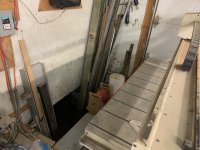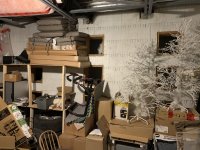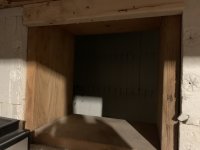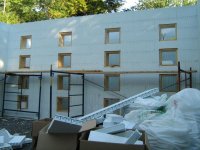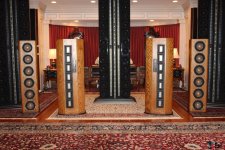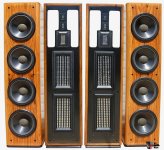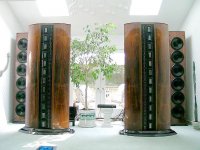Chris, my points are that
(1) 900 litres is an insane internal volume for domestic use.
(2) I doubt any commercial users would use this design and the idea of using a subwoofer which needs a fork lift when smaller lighter subs provide superior performance makes zero commercial sense... But if you like "getting your fork lift out" go ahead and knock yourself out.
(1) 900 litres is an insane internal volume for domestic use.
(2) I doubt any commercial users would use this design and the idea of using a subwoofer which needs a fork lift when smaller lighter subs provide superior performance makes zero commercial sense... But if you like "getting your fork lift out" go ahead and knock yourself out.
This is an interesting plaything:
Simulation of Linear Array of Point Sources
That's great! thanks!
diyAudio - projects by fanatics, for fanaticswas this about PA? I sort of missed that...
I thought thread starter is talking about home use
See my previous reply. No need to judge, let people have their moment of insanity. Come on, you know you want to 😀(1) 900 litres is an insane internal volume for domestic use.
(2) I doubt any commercial users would use this design and the idea of using a subwoofer which needs a fork lift when smaller lighter subs provide superior performance makes zero commercial sense... But if you like "getting your fork lift out" go ahead and knock yourself out.
You do know that some subs take the form of whole shipping containers, yeah? 😀
So started reading that book again ( never really read it throughly ..just parsed quickly before ) should be a good base to start with i believe !
This is the " infinite wall/wave " bass array for the HT i planned for the house using what i learned here back then
( please excuse the mess, temporary storage room and the garage is full of cnc dust and 2000 simultaneous projects lol )
So 16X 15" sub boxes in a concrete wall ( all walls are Insulated Concrete Forms )
with a 36" deep X 110" high and 20' long rear room that
itself is made all of ICF, which leads into a 48" by 110" "port " that goes into a second room ( under stairs kinda 60" width i think ) which then leads into the final " port "
that ends up in the garage room ( approx 30' x 25' X9' )
IIRC, i am supposed to be using 16X 15" servo controlled subs but we'll see then.
This is the " infinite wall/wave " bass array for the HT i planned for the house using what i learned here back then
( please excuse the mess, temporary storage room and the garage is full of cnc dust and 2000 simultaneous projects lol )
So 16X 15" sub boxes in a concrete wall ( all walls are Insulated Concrete Forms )
with a 36" deep X 110" high and 20' long rear room that
itself is made all of ICF, which leads into a 48" by 110" "port " that goes into a second room ( under stairs kinda 60" width i think ) which then leads into the final " port "
that ends up in the garage room ( approx 30' x 25' X9' )
IIRC, i am supposed to be using 16X 15" servo controlled subs but we'll see then.
Chris, my points are that
(1) 900 litres is an insane internal volume for domestic use.
(2) I doubt any commercial users would use this design and the idea of using a subwoofer which needs a fork lift when smaller lighter subs provide superior performance makes zero commercial sense... But if you like "getting your fork lift out" go ahead and knock yourself out.
I'm guessing, "you don't get out much", nor have see clubs thru-out time...like the floor to ceiling Phase Linear 700 series two amps at the local dance joint...or the Thirty-inch Electrovoice drivers, slickly built into the walls.
900 liters is nothing, your WAF is onerous..stand your ground, or get a bigger place..or both!
--------------------------------------------------------------------------Rick...
Oh my Richard, had a tough day in your bachelor mansion filled with big boys compensation toys and submissive young ladies?😀
Poor me I can only dream of being a super hero like you... Please forgive me for suggesting you were wrong!😉
Poor me I can only dream of being a super hero like you... Please forgive me for suggesting you were wrong!😉
Go ahead with your tofu munching, "woke", sensitive, culturally moral ideals...re-write history if you must, you'll still 'suffer' with small environmentally friendly equipment.------------------
--------------------------------------------------------------------------Rick....
--------------------------------------------------------------------------Rick....
Attachments
Last edited:
What are you guys getting at there ? I will not tolerate hijacks !!!
https://media.giphy.com/media/5SAPlGAS1YnLN9jHua/giphy.gif
https://media.giphy.com/media/5SAPlGAS1YnLN9jHua/giphy.gif
here is what you are looking for...
Nine 6.5" vs one 18" - Which do you think performs better? (x-post from r/diyaudio) : diysound
Nine 6.5" vs one 18" - Which do you think performs better? (x-post from r/diyaudio) : diysound
The two drivers used, the Dayton DCS-165 and the other, another Dayton, the PA-465S...the two couldn't be any more different, disregarding the sizes.
The DCS is the "home audio" variety, the PA is an "industrial duty" driver. As such, that big eighteen can only muster a resonant frequency of 32.3...a tribute to the four inch voice-coil ( to dissipate heat) beefy stiff spider & cloth-roll suspension.
The article was not forthcoming about tuning of the fb in the BR alignment...not much of anything else really.
---------------------------------------------------------------------Rick........
The DCS is the "home audio" variety, the PA is an "industrial duty" driver. As such, that big eighteen can only muster a resonant frequency of 32.3...a tribute to the four inch voice-coil ( to dissipate heat) beefy stiff spider & cloth-roll suspension.
The article was not forthcoming about tuning of the fb in the BR alignment...not much of anything else really.
---------------------------------------------------------------------Rick........
I was reacting to this:
What strikes me is that the "array" seems to be in a very unconventional format compared to what people prefer building. Most people making an at-home array with lots of 6.5" would have them in a line from floor to ceiling.
So at any rate...
More drivers = more holes, screws, money, time.
Performance difference = close to 0, slightly in favor of the single 18".
So I went to some sub-thread and noticed this:The array is flat on axis up to 1KHz and the 18" starts to fall appart around 400-500Hz.
The array does take longer to assemble yep, but not by heaps. As well as having 9 times the surface area, there's 9 times the bolts to tighten unfortunately... These are proof of principal designs though and not models I would consider putting into production.
The array does suffer more from distortion issues at very high SPL given it's limited Xmax however I assume up until the point it reaches Xmax, given that the smaller cones are stiffer when compared to a single large one, the array suffers less.
Further:
Phase issues do occour above 500Hz but it would be well crossed over by then.
What strikes me is that the "array" seems to be in a very unconventional format compared to what people prefer building. Most people making an at-home array with lots of 6.5" would have them in a line from floor to ceiling.
So at any rate...
More drivers = more holes, screws, money, time.
Performance difference = close to 0, slightly in favor of the single 18".
The two drivers used, the Dayton DCS-165 and the other, another Dayton, the PA-465S...the two couldn't be any more different, disregarding the sizes.
The DCS is the "home audio" variety, the PA is an "industrial duty" driver. As such, that big eighteen can only muster a resonant frequency of 32.3...a tribute to the four inch voice-coil ( to dissipate heat) beefy stiff spider & cloth-roll suspension.
The article was not forthcoming about tuning of the fb in the BR alignment...not much of anything else really.
---------------------------------------------------------------------Rick........
I fully agree with your assessment.
What is important is Fs and the fr response of smaller drivers.
If one selects small woofers with very high Fs, resulting subwoofer will have high Fs, and poor frequency response. Not equal to one large woofer with low Fs.
Fs is typically lower in woofers with bigger cone. Off course, it completely depends on the design and purpose of the woofer. There are PA woofers with very high Fs, sacrificing low frequency extension for the efficiency. That's what matters for PA more.
It all depends on the selected woofers. One can select very small woofer with low Fs, but its efficiency will suck.
Let's see what threat starter builds.
"...the array seems to be a very unconventional format." Nope, Polk Audio created these awhile ago, a two-way design. You'll know them when you see them, very tall & wide, but shallow in depth & yes, that is a passive radiator, when passive radiators were "in fashion".
----------------------------------------------------------------------------Rick..
----------------------------------------------------------------------------Rick..
Attachments
I think the array of measly little 12 inch woofers is the best way to get pp to 300 or so Hz or so. I just wish I could still find the clear poly cones.
Hi,
I know that this is maybe not the right place to discuss feelings and listening experience against technical issues, which have their use, but I´d like to offer my opinion anyway...
So far I´ve never experienced multiple small drivers having the same musical impact and power than big boy toys. 18" rules. Double 12" is a sensible compromise, but I wouldn´t want anything smaller.
But then, despite common wisdom, I personally don´t care if a woofer system goes down to 25Hz or to 35Hz, as long as the reproduction of an upright bass in original loudness, power and snap is realistic. To achieve this, power and effortless action between, let´s say 70Hz and 250Hz is needed, and the system must be CLEAN.
I personally prefer thus to have a system covering 30Hz to 250Hz with authority and impact, with big drivers.
But that´s just me... small drivers are fine for small rooms and low listening volume; for a realistic reproduction you´ll need more efforts. And the room. And the tolerant wife/girlfriend/husband/friend/family/community.
All the best
Mattes
I know that this is maybe not the right place to discuss feelings and listening experience against technical issues, which have their use, but I´d like to offer my opinion anyway...
So far I´ve never experienced multiple small drivers having the same musical impact and power than big boy toys. 18" rules. Double 12" is a sensible compromise, but I wouldn´t want anything smaller.
But then, despite common wisdom, I personally don´t care if a woofer system goes down to 25Hz or to 35Hz, as long as the reproduction of an upright bass in original loudness, power and snap is realistic. To achieve this, power and effortless action between, let´s say 70Hz and 250Hz is needed, and the system must be CLEAN.
I personally prefer thus to have a system covering 30Hz to 250Hz with authority and impact, with big drivers.
But that´s just me... small drivers are fine for small rooms and low listening volume; for a realistic reproduction you´ll need more efforts. And the room. And the tolerant wife/girlfriend/husband/friend/family/community.
All the best
Mattes
I think the array of measly little 12 inch woofers is the best way to get pp to 300 or so Hz or so. I just wish I could still find the clear poly cones.
I am fully aware that pictures I posted are not what thread starter is asking about.
"...the array seems to be a very unconventional format." Nope, Polk Audio created these awhile ago, a two-way design.
not conventional; not bound by or conforming to convention, rule, or precedent; free from conventionality:
SYNONYMS FOR UNCONVENTIONAL
eccentric, individualistic, idiosyncratic, atypical.
Could well be there are heaps of designs that rely on making arrays like this, but a single design example does not make it conventional IMO.
Jim, did you decide on further progression? Started looking at drivers?
I can't seem to find anything about that subject either here or on tubes ,
would be greatful if you knowledgeable guys could chime in a bit on that to enlighten a total noob as meself 🙂
So simply, what would be the result of using a large quantity of smaller diameter woofers or midranges against using traditional single dual or few pretty large woofers/subwoofers .
Not trying to go into specifics here, only trying to understand how all this works slowly so my little brain can process it one bit at a time
This questioning came to mind when trying to understand relation between mass of drivers ( moving mass ? ) vs speed and sound pressure .
Wouldn't a multitude of lower mass drivers have better response and decay than a much larger single unit for the same perceived volume ?
Thanks for your time 🙂
If this has been mentioned, ignore this.
But the most fundamental law of nature states that force equals mass times accelleration. Iow F=mxa.
You want to change more mass, you need more force.
There's no such thing as fast or slow bass. Frequency response is king and for a smooth low frequency response, you need multiple subs or a massive amount of basstraps.
- Home
- Loudspeakers
- Subwoofers
- Using a ton of smaller woofers for bass ...

